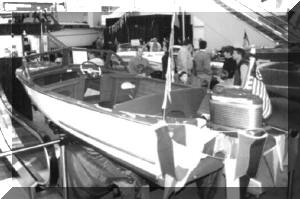by Jerry Valley
This is the third and final chapter in the restoration of my Lyman. For those of you who have been following this restoration, you will notice that the boat has grown a foot since the last article was written. As I was reassembling the boat, I noticed on the bottom of one of the seats a notation 57 16 ½.  Even though it is registered as a 15 ½ I decided to measure it and it is, in fact, 16 ½ long. Lyman made both lengths in 57 so it is a reasonable possibility. Subsequent to that initial finding, I found the same marking on several other pieces. Im not sure when or how it got mis-registered but it was sold to me as a 15 ½ boat.
Even though it is registered as a 15 ½ I decided to measure it and it is, in fact, 16 ½ long. Lyman made both lengths in 57 so it is a reasonable possibility. Subsequent to that initial finding, I found the same marking on several other pieces. Im not sure when or how it got mis-registered but it was sold to me as a 15 ½ boat.
Jerry Valley’s Lyman at Minneapolis Boat Show Anyway, that discovery aside, there was a significant change of plans since the last article was written. My plan at the time had been to store the boat for the winter and then continue the restoration in the spring. However, I was approached in the fall and asked if I would be interested in displaying my 1960, 23 Lyman at the January 99 boat show at the Convention Center. While honored to be asked, I didnt feel that boat was currently of a standard to be shown. In a very weak moment I suggested I should finish the small Lyman and show it instead. This from someone with a boat not even half-finished, winter on the way and with an unheated, uninsulated, very drafty garage! It has proven to be a challenge but as the boat show approaches (as I write this article it is only 6 days away!) the end is in sight. I have only to install a few small pieces of trim, the floorboards and the outboard and it will be ready for the show.
The previous article ended with the exterior of the hull, including the bottom, having been completed. I was just getting started on rough fitting the deck planking. I had also restored the trailer while the boat was upside down on a dolly. A friend then helped me turn the boat over and put it back on the trailer for the balance of the restoration. In order to work on the boat in the garage while on the trailer, I had to cut a hole in the front of the garage and allow the trailer tongue to protrude outside. This was met with some amusement by my neighbor (and, fortunately, my wife as well).
Remaining to be completed before the show was installation, trimming and fitting of the deck planking as well as sanding, staining, sealing and varnishing of it. The gods were with me, and, as you will recall, we were blessed with a much warmer than usual fall and early winter. This allowed me, with the help of a smelly kerosene heater, to keep the garage warm enough to get 8-9 coats of varnish on before it turned really cold. Throughout the restoration of this boat, I have used Sika Flex as a bedding compound, Interlux Chris-Craft Mahogany filler stain, Petitt 2018 sealer and Interlux Clipper Clear varnish, all with very satisfactory results.
Once the decks were finished, it was time to install the new forward bulkhead, windshield, side windows, dash, steering wheel, seats, cabinets and floorboards, all of which had been refinished in the basement the previous winter. In spite of the addition of a propane heater to my sources of heat, most of this work has been completed in a very, very cold garage, painfully cold at times. With the boat show date looming ever closer, however, there was no option but to press on.
The original glass (or at least the glass that was in the boat when I purchased it) was a very unattractive shade of green, so I had all new safety glass cut using the original glass for patterns. On the recommendation of Dan Nelson, a member of the club and a professional restorer, I used Hoffer Glass on Lyndale Ave. They provided fast service, reasonable prices and high quality, so if you need glass, I highly recommend them.
Last but not least was installation of the hardware. The only thing salvageable from the original boat was a cute little chrome horn mounted on the deck just forward of the windshield. I was able to polish this up and bring it back to presentable, if not perfect, condition. The rest of the hardware is new. I have installed some additional hardware which I feel is important but which was not on the original boat, including a stainless rub rail, bow chocks and stern cleats. I also added stainless rub strips to the varnished spray rails to protect them from damage. While the wiring and motor controls still need to be installed, this will have to wait until summer. All in all, this has been a very fun and rewarding project and I am delighted that the finished product will have been at the boat show. I cant wait to get it in the water next summer.
My original goal was to complete this project in about two years at a total cost of around $3000. I have succeeded on both counts, learned much in the process and had a lot of fun doing it.
So there is more proof that an old beat up boat is really potential treasure. It is good that Jerry is a believer in — dont destroy it; restore it!

